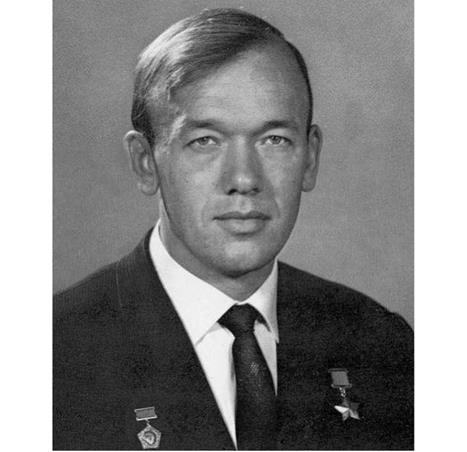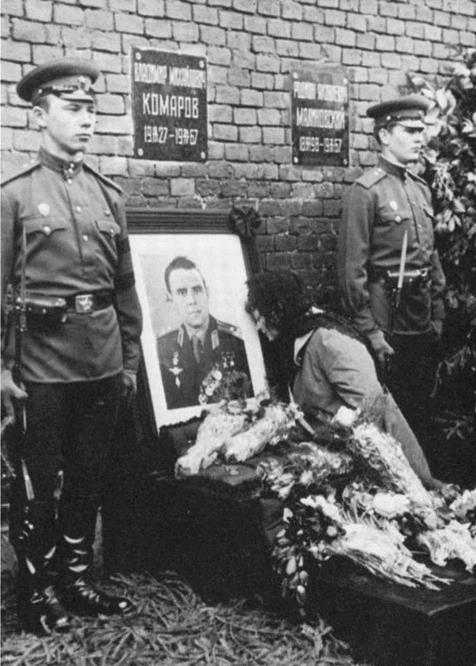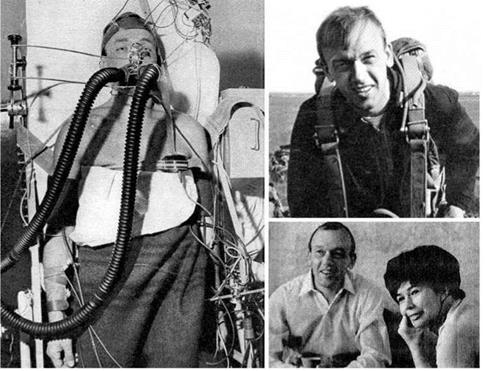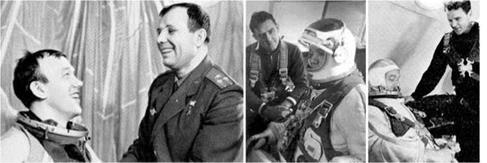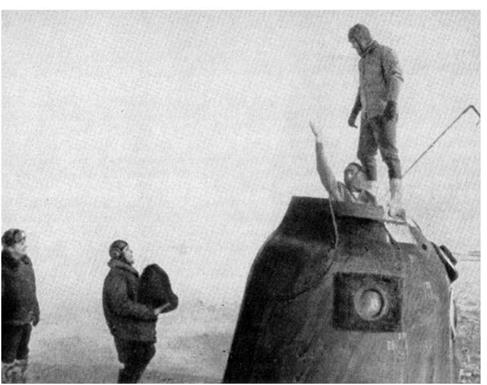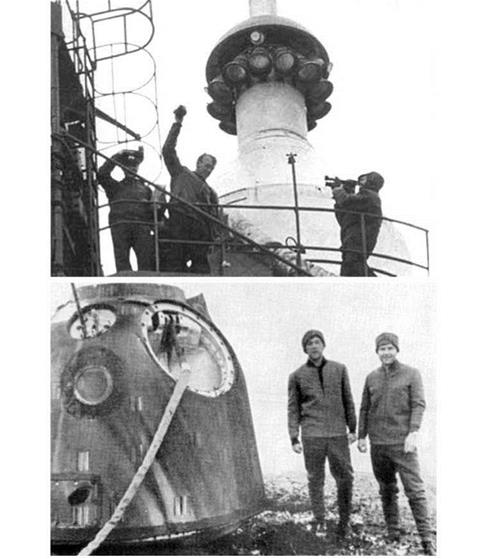“INTERESTING THINGS ATTRACT ME”
Just as Shatalov stood out in the military cosmonauts, so did Yeliseyev among the TsKBEM’s civilians. He was the first member of the group of cosmonaut-engineers selected in May 1966 to be assigned to a prime crew: after 3 months of training he was nominated as flight engineer of the crew which, if Soyuz 1 had not encountered difficulties, would have been launched on board Soyuz 2 to perform a joint mission involving a docking and an external transfer. When this task was finally achieved in January 1969, Yeliseyev became the third Soviet cosmonaut to make a spacewalk.[32] On being assigned to a backup crew for the ‘group flight’ later that year, Yeliseyev had only one month’s notice that he would fly on Soyuz 8. The next year, he started to train for his third mission.
Aleksey was born on 13 July 1934 in the small town of Zhizdra – near Kaluga, which is famous for Konstantin Tsiolkovskiy. His father, Stanislav Kuraytis was of Estonian origin, and worked in the laboratory of a shoe factory. Before Aleksey was one year old, his father was accused of being an enemy of the Soviet Union and was sentenced to five years in prison; but stayed incarcerated for almost a quarter of his life.[33] After her husband’s imprisonment Aleksey’s mother, Valentina Ivanovna, remarried. She worked as a chemist for the Soviet Academy of Sciences, and later gained a PhD degree. When the Second World War began they were in Moscow, and young Aleksey joined his childhood friends in collecting scattered bomb parts from German aircraft. When his mother was transferred to a factory to Siberia, Aleksey was sent to stay with his grandparents in Kazakhstan, where he gained his first schooling. He moved back to Moscow in 1943 when his mother returned to give birth to her second son. In 1950 Aleksey adopted the surname of his mother – Yeliseyev. One year later he finished high school in Moscow. The next step was the Bauman Higher Technical School (MVTU), which was one of the two leading universities in the city for aeronautical engineering and also, as events would show, for educating the future designers of space vehicles. He particularly favoured physics, mathematics, engineering and, of course, chemistry, but was also keen on sports, twice winning the national fencing championship, and he enjoyed the poetry of Vladimir Mayakovskiy.
Following his graduation in 1957, Yeliseyev was assigned to one of the top-secret scientific research institutes to work on theoretical aspects of the aerodynamics of cruise missiles and rockets. The launch of Sputnik shocked him, because he had no idea that there was an institution in the country devoted to the development of a real rocket capable of placing a satellite into orbit. He wanted to join that effort. In the early days, Boris Raushenbakh’s team was the leader in rocket dynamics. Some of its engineers were developing the guidance system for an automatic probe intended to travel on a trajectory behind the Moon in order to photograph the region that was never directly visible from Earth. When Yeliseyev heard of such work, he felt he had to join Raushenbakh immediately. However, as he was only in a training post, this was not possible. To acquire the necessary status, he applied to the Moscow Institute for Physics and Technology (MFTI), and in late 1959 was allowed to join Raushenbakh’s team – which had been incorporated into OKB-1 and was working for Korolev. In the meantime, Yeliseyev had married Valentina Pavlovna Shpalikova, who worked as a mechanical and hydraulic engineer, and in March 1960 their single child was born: daughter Yelena.
|
Aleksey Yeliseyev, the Soyuz 10 fight engineer. |
At OKB-1, Yeliseyev was made aware for the first time of a super-secret project to develop a vehicle to enable a man to fly in space: project 3KA, which was later to become famous by the name of Vostok. He worked on the design of the systems to enable the pilot to control the spacecraft. When in April 1961 Yuriy Gagarin became the first man to orbit the Earth, Yeliseyev asked Konstantin Bushuyev, one of the most influential managers at OKB-1, to assist him in becoming a cosmonaut. Although surprised by the young engineer’s request, Bushuyev agreed, and in late 1962, soon after his graduation from the MFTI, Yeliseyev went to the Central Air Force Scientific Research Hospital (TsVNIAG) – which the cosmonauts had named the ‘Palace of the Fords’. Another OKB-1 engineer, Vitaliy Sevastyanov, was also present. In fact, both men had applied without the knowledge of their boss, Korolev. Yeliseyev suffered a minor difficulty when the pressure in the altitude chamber was reduced to that at an altitude of 5 km, but when the test was repeated he performed satisfactorily. Actually, this first and most complex phase of the medical testing was so rigorous that only 1 in 20 of the candidates passed. Those who did so had a good chance of being selected to become cosmonauts. Yeliseyev advanced to the second phase of medical testing. However, one day Korolev visited the hospital to discuss changes in the medical criteria for civilian cosmonaut candidates. He had believed from the beginning that the best people to fly in space were the engineers who had designed the spacecraft. He had a very difficult meeting with the Air Force military doctors. He explained that the civilian engineers were very busy, and therefore did not have as much time to spend on sporting activities as did the military pilots. He requested that the criteria for the civilians be relaxed. On the other hand, the Air Force doctors, well aware that General Kamanin had never liked the idea of sending civilians into space, insisted that only people in perfect physical conditions should fly. Finally, one of doctors mentioned a civilian engineer by the name of Yeliseyev whom they were in the process of testing and was just as fit as the best military men. Korolev ordered the doctors to remove Yeliseyev from further consideration, and on returning to Kaliningrad demanded an explanation of how one of his engineers could have applied to become a cosmonaut without official approval. Raushenbakh advised Yeliseyev that he should avoid contact with Korolev until the metaphorical dust had settled.
After his unsuccessful attempt to become a cosmonaut, Yeliseyev continued with his task of developing systems for controlling spacecraft. In addition, he took part in calculations of the fuel consumption for two Vostok spacecraft that were launched on a ‘double flight’ in June 1963, one of which carried Valentina Teryeshkova, who became the first woman to fly in space. During the entire mission, Yeliseyev was on duty at OKB-1, prepared to answer any technical questions from the control team at Baykonur. Undeterred by his dismissal from the medical screening for a cosmonaut, in 1963 he passed a special training course at the TsPK for the Air Force’s second cosmonaut group. His first visit to Baykonur was in October 1964, to participate in the preparations to launch the three-man Voskhod. At the same time, his colleagues were planning the first spacewalk. As an expert in spacecraft dynamics, Yeliseyev was included in a group of engineers who studied how a cosmonaut could move in open space, and how the vehicle could be controlled while a cosmonaut was outside. Tests were performed by simulating weightlessness in a Tu-104 aircraft. Following Leonov’s pioneering spacewalk in March 1965, Yeliseyev was assigned to work on the development of the control systems of the Soyuz spacecraft, which was not only to operate in Earth orbit but also, in a modified form, undertake the L1 circumlunar mission. On returning at high speed from a lunar trajectory, the L1 was to perform a manoeuvre involving penetrating the atmosphere twice, the first time at about 11.2 km/s, corresponding to its original ‘escape’ speed, and then, after some braking, it was to re-emerge from the atmosphere on a ballistic arc that would lead to a second entry at a speed more comparable with that of returning from a low orbit. Yeliseyev investigated the deceleration loading imposed by such a manoeuvre. This led to one of the most unusual experiments of his career: testing the ability of a cosmonaut to manually control a vehicle under high deceleration loads. Some of the subjects of these tests were able to survive 26 g for 70 seconds!
As Yeliseyev recalls of his own participation in these trials: ‘‘You experience the increase in load as an increase in weight. You feel as if your body was poured with steel. A force is pressing you into your seat stronger and stronger. At 4 g, you can’t move your legs, just your arms. At 8 g, your vision goes and you can’t see beyond your nose. Then as the loads increase, you can see only a strange granular pattern. At 12 to 14 g, you can’t see anything. Breathing is almost impossible. The forces that strain your muscles to avoid blood spouting out reach their maximum levels. You can’t do anything; you just hope that you have enough strength left to endure it. The maximum load that I was exposed to was 18 g. Each time that I passed 14 g, I thought it was the end. It is interesting that my sense of hearing remained unaltered. I could hear even during the highest gravity forces. From this I concluded that we should use sound signals to control our lunar spacecraft during re-entry!’’
In July 1965 a group of OKB-1’s young engineers passed the preliminary medical screening for consideration as potential cosmonauts. Having concluded that the Air Force was inappropriately assessing civilian engineers, Korolev had decided not to send OKB-1’s candidates to the ‘Palace of the Lords’ for the medical examinations, and instead employed the Ministry of Health’s Institute of Biomedical Problems. In general the screening was similar to that of the Air Force, but it was shorter and included a psychiatric interview. Yeliseyev was very intrigued by this interview: ‘‘I remember that the majority of my colleagues were irritated by the psychiatrist. The interview lasted 3 to 4 hours. He asked us about our grandparents: did we remember our grandmothers and grandfathers and the most common topic of their arguments? He wrote in his notes much more than we actually spoke! Now a question about our other relatives. And again he scribbled. He did not permit smoking although he was himself smoking. We were all very careful during this interview. If we didn’t fully concentrate he might infer from our replies that we had a psychological anomaly – and then it would be impossible to disprove his conclusion.” But Yeliseyev satisfied the psychiatrist, and on 23 May 1966 was accepted as one of the eight members of the TsKBEM’s first group of cosmonaut-engineers.[34]
From May to August 1966 the group undertook basic training at the TsKBEM, as well as parachute jumps, tests in an isolation chamber and simulated weightlessness in a Tu-104 aircraft. In late August, they trained for the possibility of landing on water. This latter training was performed on the Black Sea, and also involved a group of military cosmonauts from the TsPK.
When the cosmonaut-engineers were sent to the TsPK to start training for Soyuz missions, Kamanin intervened, saying that he would not permit them to train there unless they satisfied the standard medical screening! One week later, the ‘Palace of the Lords’ accepted only Kubasov, Volkov, Yeliseyev and Grechko. On 6 September they started to train as candidates to serve as flight engineer on a mission involving an external transfer between two docked spacecraft. In October, Grechko broke his leg in parachute training and was replaced by Oleg Makarov.
In selecting the crews for the spectacular joint mission that was to introduce the
Soyuz spacecraft, it was natural, given his experience in planning Leonov’s historic spacewalk, that Yeliseyev should be assigned as one of two cosmonauts who were to undertake the external transfer from Soyuz 2 to Soyuz 1. After his appointment, Yeliseyev received an unusual request: the psychiatrist wished to speak to his wife and mother! The reason, he was told, was that the psychiatrist wished to know how Yeliseyev would react if a serious problem were to occur during the spacewalk. For example, would he become hysterical and respond only to the voice of a woman he regarded as being special to him. Yeliseyev was against the idea. His mother had no idea that he was a cosmonaut. And he did not wish to involve Valentina Pavlovna because their marriage was coming to an end.[35]
Colonel Komarov was to command Soyuz 1. Having flown on the 1964 Voskhod mission, this would make him the first cosmonaut to have a second flight in space. Soyuz 2 would set off 24 hours later with Valeriy Bykovskiy, Yevgeniy Khrunov and Yeliseyev. Komarov would rendezvous and dock. Khrunov and Yeliseyev were to don spacesuits and transfer to Soyuz 1. After undocking, Soyuz 1 would return to Earth at the end of its third day in orbit, with Bykovskiy doing so 24 hours later. It was very ambitious inaugural mission for the new spacecraft. The Soviet Union had not sent anyone into space since March 1965. Meanwhile, the ten American Gemini missions had made the first orbital rendezvous (involving two manned vehicles) and also the first docking (using an unmanned target), had conducted several one-man spacewalks, and had set the endurance record at 14 days, all of which put them in a good position to prepare for a lunar landing mission. However, if all went well the Soyuz 1/2 mission would enable the Soviet Union to catch up in a highly dramatic manner.
Unfortunately, Soyuz 1 ran into difficulties immediately upon attaining orbit. The State Commission ordered the launch of Soyuz 2 cancelled, and everyone focused their efforts on enabling Komarov to return to Earth at the first available opportunity. Although the spacecraft circled the Earth every 90 minutes or so, the rotation of the planet meant that the best opportunities to make a landing in the recovery zone were either after one revolution or after 24 hours. The state of the spacecraft precluded an immediate return. Komarov gained sufficient control of the vehicle to attempt to return the next day. However, just as everyone thought that the worst was over, the parachute system failed, the descent module smashed into the ground at great speed, and he became the first man to lose his life on a space flight. In fact, the outcome could have been worse – when the parachute system of Soyuz 2 was tested, it was found to have the same flaw. If Soyuz 1 had operated correctly in orbit and Soyuz 2 had been launched, then all four cosmonauts would have been lost!
While the design of the Soyuz spacecraft was being modified to rectify the faults, training continued. In December 1967 Yeliseyev was granted an M. Sc. (Technical). In February 1968 Bykovskiy left the docking group to train for the L1 circumlunar mission, and was succeeded by Volynov. Although Yeliseyev was not a member of
|
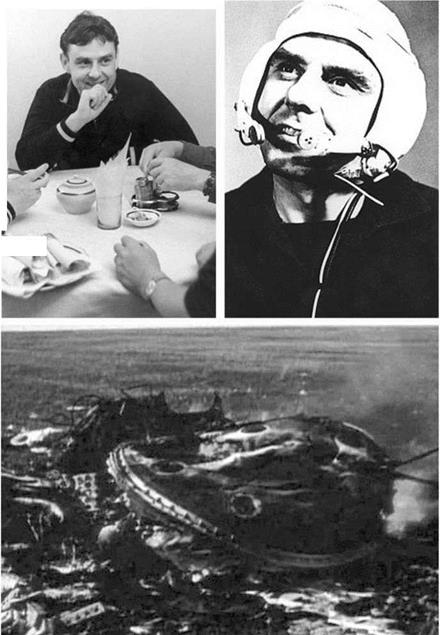
|
Komarov’s ashes are interred in the wall of the Kremlin. |
any lunar crew, he participated in training involving aircraft flying over Somalia at night, the objective being to enable the cosmonauts to familiarise themselves with the constellations of the southern sky that were to be used in navigating the first of the two atmospheric entries of a returning circumlunar mission. In late May 1968 it was decided to revise the ambitious ‘inaugural mission’ plan by launching the first of the two Soyuz spacecraft unmanned. Only if this functioned satisfactorily would the second spacecraft be launched with a single cosmonaut to make the rendezvous and docking. Unfortunately, although Beregovoy in Soyuz 3 rendezvoused with the unmanned Soyuz 2, he was unable to dock. However, because both spacecraft had performed satisfactorily, it was decided to proceed with the ‘full’ mission involving an external transfer.
When Yeliseyev was launched into space in January 1969 on Soyuz 5, more than 27 months had elapsed since he received the flight engineer assignment. He recalls of his 37-minute spacewalk: ‘‘Travel along the external surface of the ships proved to be the easiest and most pleasant part of the transfer. It barely required any effort. The ‘landscape’ gave the sensation of limitless space and freedom. It was similar to the experience prior to a jump from an aircraft, but in this case there was no wind – and there was no concern about the operation of the parachute! I paused in order to memorise what I could see. Below was the ship that we had left. To the left, shaped like the top of a bell, was our descent module. Volynov was inside, alone. Beyond was a module housing the instruments, the engines and the solar panels. To the right was the second ship, of the same type as ours. I could see Khrunov, his torso safely inside the orbital module of Soyuz 4, holding onto my cable. Far, far away, was the Earth’s horizon, whitish-blue, passing very slowly. Above the horizon everything was black. Probably the light reflecting from the ships and the filter of my space helmet prevented me seeing the stars and planets. I slowly unclenched my fingers to try to float without holding onto the handrail. By having a safety line, releasing the handrail posed no danger. I walked further -1 say ‘walked’, although I do not know how to name this method of movement. Do I crawl? Swim? Fly? My feet played no part. It was simply hand over hand on the rail – as if passing this to someone. But ‘spacewalking’ has become the accepted term. When I approached the hatch of the orbital module, Khrunov had entered fully and was against the far wall so as not to interfere with my entry. I freely swam through the hatch, we gathered the cable and informed Shatalov that we were going to close the hatch. The transfer was finished. It remained only to fill the orbital module with air, to verify its hermetic seal, and to remove our spacesuits.’’ Shatalov, Yeliseyev and Khrunov landed the next day, and Volynov the morning after.
After a well-earned vacation in Central Asia, Yeliseyev returned to the TsKBEM, where the final preparations for the next big event were well in hand. The plan was to launch three manned vehicles at daily intervals in October 1969. Georgiy Shonin and Valeriy Kubasov would go up first in Soyuz 6. Anatoliy Filipchenko, Vladislav Volkov and Viktor Gorbatko would follow in Soyuz 7. Then Andriyan Nikolayev and Vitaliy Sevastyanov were to dock Soyuz 8 with Soyuz 7. Yeliseyev was put on a common backup crew. One morning Mishin called Yeliseyev into his office and asked him to fly on Soyuz 8. This took Yeliseyev by surprise: ‘‘I knew that the crew
|
Yeliseyev in medical testing (left), parachute training and with his second wife Larisa. |
|
|
In late 1966 Yeliseyev began to train for the mission in which two Soyuz spacecraft were to dock and cosmonauts were to make an external transfer from one vehicle to the other. He trained with numerous cosmonauts, including Gagarin (left), Komarov (middle) and Shatalov (right).
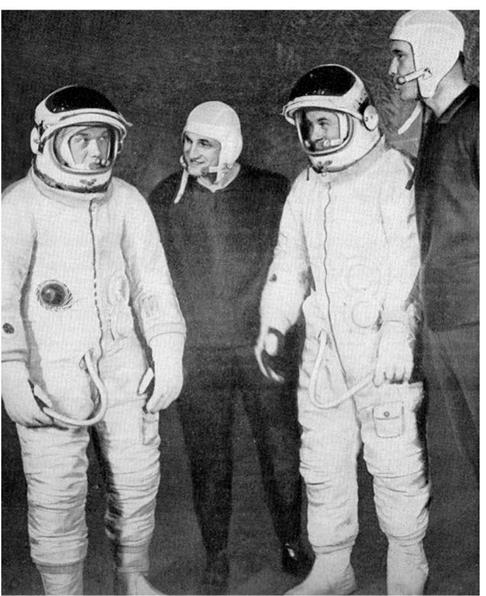
|
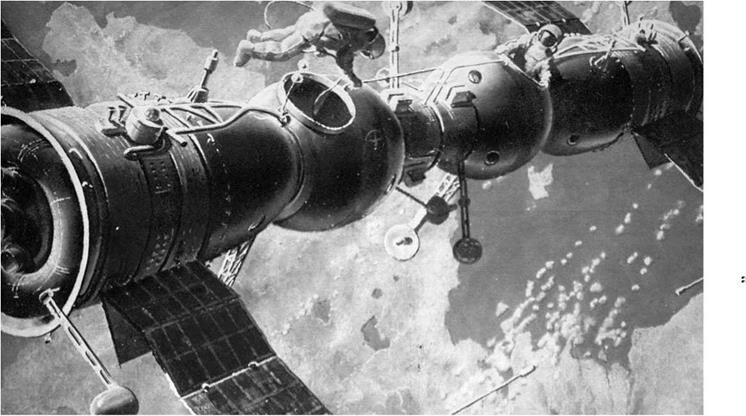
An artist’s depiction of the historic external transfer from Soyuz 5 to Soyuz 4, showing Khrunov (right, in the hatch of Soyuz 4) watching Yeliseyev begin his spacewalk. Note that artist Andrey Sokolov showed the cosmonauts wearing their life support systems as backpacks, whereas in fact they attached the packs to their legs.
 so
so
|
A member of the recovery team assists Yeliseyev (waving) from the hatch of the Soyuz 4 descent module, as Shatalov stands on the left. Another member of the recovery team stands alongside the capsule with the warm clothes for Yeliseyev. Khrunov is not visible. |
of that ship was ill prepared, but I did not expect such a turn of events. The missions were less than two months off. The three crews had already had their examinations. I looked at Mishin interrogatively, and waited for an explanation.”
“I do not want to let that crew fly!” said Mishin. “They work thoroughly badly.” “But, I have not prepared,” Yeliseyev pointed out.
“The programme is almost the same as yours from the previous flight, without the transfer. You will succeed.”
When Yeliseyev agreed, Mishin telephoned Kamanin: “Nikolay Petrovich, I can’t permit the Soyuz 8 crew to fly; they work badly. For my part, I nominate Yeliseyev. Select someone from your stronger cosmonauts.’’
Kamanin was surprised at Mishin’s late intervention, but after a brief objection he agreed that Nikolayev should not fly. The next day Mishin and Kamanin met at the TsPK and, after an unpleasant conversation, agreed to send Shatalov and Yeliseyev. One by one, the three spacecraft were placed into the required orbits, but the Igla rendezvous system on Soyuz 8 malfunctioned and there was no equipment available to control the operation manually. At mission control, ballistic experts improvised a plan to enable Soyuz 8 to perform manoeuvres which would bring it within several hundred
|
Shatalov and Yeliseyev on the launch tower prior to entering Soyuz 8 (top), and alongside the descent module just after the landing. |
metres of its target and then, when the crews could see each other, perhaps they would be able to dock manually. But everyone was aware that the likelihood of success was almost zero. The controllers supplied Soyuz 8 with the manoeuvre data, and where they should look for Soyuz 7. Yeliseyev was to observe through the portholes set at 90-degree intervals around the orbital module, to locate their target visually. Shatalov was to remain at the controls of the descent module and turn his
spacecraft as instructed by Yeliseyev until Soyuz 7 entered the field of view of his forward-looking optical periscope. Yeliseyev saw a bright dot travelling against the clouds beneath, but the range was impossible to judge. He recalls: “We wanted so much to dock, and we tried everything that we could. We had to hold visual contact with Soyuz 7 for the entire period of the approach, while attempting to match our speeds. Shatalov attempted to use the orientation engines on a continuous basis, but these small engines were incapable of cancelling the speed difference, and Soyuz 7 flew by and disappeared.” There was insufficient fuel to set up another rendezvous attempt. Soyuz 8 landed after 5 days in space, and although the primary objective of docking had not been achieved, the ‘group flight’ was officially another success in Soviet cosmonautics.
Although everyone was disappointed, there was no time to dwell on this failure, and within 7 months Yeliseyev was back in training in the expectation that his third flight would be a truly historic one.











